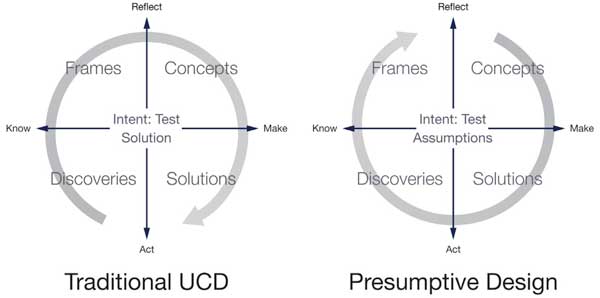[greybox]
 A review of
A review of
Presumptive Design: Design Provocations for Innovation
by Leo Frishberg and Charles Lambdin
Twitter: @leofrish and @CGLambdin
About this book
A good reference for Methods/How-To, Case Studies
Primary audience: Researchers and designers with some or significant experience with the topic
Writing style: matter-of-fact with equal parts text and images
Publisher: Morgan Kaufmann, 2015, 414 pages, 13 chapters
Learn more about our review guidelines
[/greybox]
“Presumptive Design: Design Provocations for Innovation” by Leo Frishberg and Charles Lambdin begins with the bold assertions that:
- We are frequently wrong about what design is needed to solve a problem
- We deny we are wrong
- We don’t like learning that we are wrong
To presume can mean one of two things: to simply do something as if it’s true or to be audacious enough to do something where it’s more like a dare. Presumptive Design, aka PrD, combines both of these definitions. It instructs designers to present designs based on presumptions as somewhat of a dare to provoke reactions that get to insights about what’s needed and better solutions. This method actually builds off our often wrong presumptions about design solutions as a way to move design teams closer to a functional design.
The method starts by creating something (almost anything) in a creation session based on the team’s presumptions about what’s needed. Next, rapid prototyping is used to visualize a solution to get feedback (requirements) through an evaluation session.
An appealing aspect of the author’s thesis is how their method helps to overcome the issues that arise when UX practitioners are brought in too late on a project. Similarly, too often we propose doing user experience research that rarely gets funded. Presumptive design solves these challenges by identifying needs, as well as evaluating designs quickly and cost-effectively. When done successfully, it’s quite an amazing feat and will change how you think about prototyping.
It takes the authors more than 400 pages to fully explain Presumptive Design. Both authors do a thorough job of setting up the method, taking us out on a few drives and then reminiscing about the drive with you. The book is structured really well with clear references to upcoming chapters, what else to read, a summary at the end of each chapter, and lots of resources intermingled. I like the book’s recipe-like approach, with strong points-of-view for things like holding creation sessions in person, timelines, who should be involved, the roles needed, and ways to help you plan the logistics of exercises. They illustrate lots of examples and details to get there. They also have an impressive array of experts who are referenced and leveraged throughout to lend credibility. The authors do a stellar job of referencing existing methods and weaving their insights together. In some sense, this book is a good history of UX research and Design Thinking methods.
To continue the conversation, it would be useful for the authors to engage readers by creating a forum to allow those who have used their method to discuss it. I also believe there are a lot of differences between applying this method in a corporate setting versus an agency setting. Providing support or ideas for how practitioners can apply this method in different contexts would be useful.
Overall the book is persuasive in documenting how this new method can be a universal source of inspiration. It is one of the most radically different methodologies I’ve seen in a long time. I would recommend it to more seasoned practitioners and likely those in corporate settings; but those working in agencies would benefit from its ability to let one do quick deep dives into a new domain.
[bluebox]
PrD and Sato’s Design Thinking Model
Traditional UCD relies on the same cycle proposed by Kumar and Sato: Begin by identifying the problem, frame it through analysis, craft concepts, and ultimately craft prototypes and solutions. But in the Alice-through-the-looking-glass world of PrD, things go very differently: PrD relies on exactly the same steps, but starts the process 180° away in the upper right quadrant.

As the image suggests, PrD starts in the “concepts” quadrant, moving quickly through “solutions,” and then into the “discoveries” quadrant, ultimately proceeding from there around the circle. This simple rotation addresses two key challenges facing researchers in today’s rapidly changing environments:
- It “gets to the point” right off the starting line. Time spent in research is directed and focused on the things that matter most to the organization.
- It forces the internal team to put their assumptions on the table immediately, and then immediately puts those assumptions in front of customers and users.
When performed correctly, PrD quickly moves the entire team through the cycle, enabling them to view their assumptions through their external stakeholders’ eyes. As David McKenzie notes in The Case of the Balking Bicyclists, nothing changes a team’s mind more quickly than having a customer trash its great ideas!
[/bluebox]
